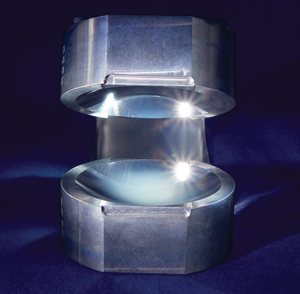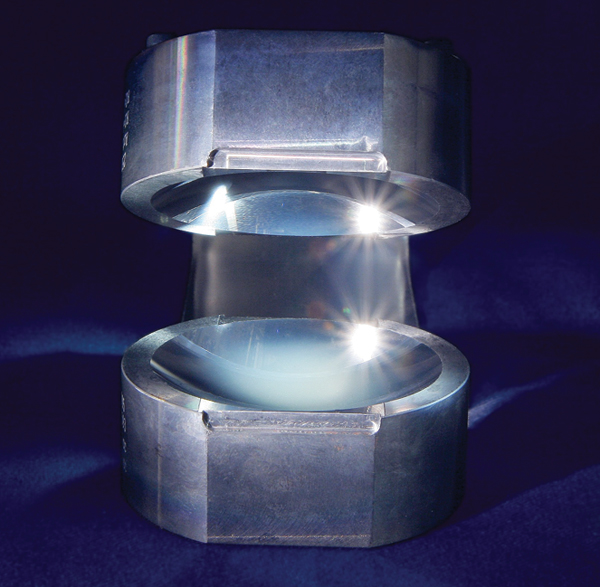Nobel Prize—Tools for Quantum Tinkering
To understand the quantum world, researchers have developed lab-scale tools to manipulate microscopic objects without disturbing them. The 2012 Nobel Prize in Physics recognizes two of these quantum tinkerers: David Wineland, of the National Institute of Standards and Technology and the University of Colorado in Boulder, and Serge Haroche, of the Collège de France and the Ecole Normale Supérieure in Paris. Two of their papers, published in 1995 and ‘96 in Physical Review Letters, exemplify their contributions. The one by Wineland and collaborators showed how to use atomic states to make a quantum logic gate, the first step toward a superfast quantum computer. The other, by Haroche and his colleagues, demonstrated one of the strange predictions of quantum mechanics—that measuring a quantum system can pull the measuring device into a weird quantum state which then dissipates over time.
A quantum system can exist in two distinct states at the same time. The challenge in studying this so-called superposition of quantum states is that any nudge from the environment can quickly push the system into one state or the other. Wineland and Haroche both designed experiments that isolate particles—ions or photons—from the environment, so that they can be carefully controlled without losing their quantum character.
Since the 1980s, Haroche has been one of the pioneers in the field of cavity quantum electrodynamics, where researchers observe a single atom interacting with a few photons inside a reflective cavity. Haroche and his colleagues can keep a photon bouncing back and forth in a centimeter-sized cavity billions of times before it escapes. But only photons of specific wavelengths determined by the cavity size can survive. Haroche’s group was one of the first to show that this wavelength selectivity could amplify [1] or suppress [2] the emission from an atom inside the cavity. Haroche was later able to tune a cavity so that the allowed wavelengths were close to, but not equal to, those associated with transitions in an atom, so that the photons and atom did not exchange energy. Instead, they incurred a phase change that could carry information about, for example, the number of photons in the cavity [3].
In 1996, Haroche’s group used such a system to study the process by which a quantum superposition settles into a single state. The researchers placed a highly excited rubidium atom in a superposition of two energy states and then sent it through a cavity containing about ten photons. The matter-light interaction “entangled” the photons and atom together, so that the photons entered their own superposition of two states (a “Schrödinger cat” state, in the team’s language), which acted as a “measurement” of the atom’s superposition state. Measuring devices don’t ordinarily remain in two states; instead, they give up their quantum nature almost immediately through interactions with the environment. However, this so-called decoherence process was expected to take longer for a “small” device with only a few particles (photons in this case).
To see this effect, the team arranged for a second atom to enter the cavity shortly after the first. Separate observations of the atoms after each passed through the cavity showed that the superposition in the photons survived for several microseconds. This was the first experimental exploration of the quantum measurement process at the so-called “mesoscopic” boundary between the macroscopic and the microscopic world, says coauthor Jean-Michel Raimond of the Pierre and Marie Curie University in Paris. “The experiment is even now described in a few standard quantum mechanics textbooks,” he says.
Wineland performed similar sorts of quantum-probing experiments through his own pioneering work with trapped ions [4,5]. The tight confinement of ions in these electric field traps causes ion motion to be restricted to distinct quantum states, each of which represents a different frequency of bouncing back-and-forth between the electric field “walls.” These motional, or “vibrational,” states are typically independent of the internal, electronic energy states of the ion, but Wineland and others showed that laser light could transfer energy from one set of states to the other. The researchers used this laser coupling to cool an ion to the state with the slowest motion [6] and to make the world’s most precise clocks [7].
In their 1995 paper, Wineland and his colleagues demonstrated the first quantum logic gate, the basic building block of a quantum computer. They trapped a single beryllium ion and prepared it with two quantum bits (quantum two-state systems, or “qubits”): one corresponding to the two lowest vibrational states and the other to a pair of electronic states. A series of laser pulses would either have no effect on the electronic qubit or would switch its value—say, from the lower- to the higher-energy state—depending on the vibrational qubit’s state. This “controlled NOT” operation did not measure either qubit, so the quantum nature of the states was preserved. “It was a simple gate, but it was interesting because it was clear how to scale the system up,” says coauthor Chris Monroe of the University of Maryland in College Park. Since then, researchers have succeeded in performing more complicated logic operations with as many as 14 ions.
“There is a beautiful duality between the two techniques,” Raimond says. Wineland traps matter particles (ions) and studies them with laser beams, while Haroche traps photons and studies them with a matter beam. “I think the match by the Nobel committee is quite perfect: Same generation, similar achievements, same global objectives,” says Raimond, “and two excellent friends.”
–Michael Schirber
Michael Schirber is a Corresponding Editor for Physics Magazine based in Lyon, France.
References
- P. Goy, J. M. Raimond, M. Gross, and S. Haroche, “Observation of Cavity-Enhanced Single-Atom Spontaneous Emission,” Phys. Rev. Lett. 50, 1903 (1983)
- W. Jhe, A. Anderson, E. A. Hinds, D. Meschede, L. Moi, and S. Haroche, “Suppression of Spontaneous Decay at Optical Frequencies: Test of Vacuum-Field Anisotropy in Confined Space,” Phys. Rev. Lett. 58, 666 (1987)
- S. Gleyzes, S. Kuhr, C. Guerlin, J. Bernu, S. Deléglise, U. Busk Hoff, M. Brune, J. M. Raimond, and S. Haroche, “Quantum Jumps of Light Recording the Birth and Death of a Photon in a Cavity,” Nature 446, 297 (2007)
- D. J. Wineland, R. E. Drullinger, and F. L. Walls, “Radiation-Pressure Cooling of Bound Resonant Absorbers,” Phys. Rev. Lett. 40, 1639 (1978)
- D.J. Wineland and Wayne M. Itano, “Spectroscopy of a Single Ion,” Phys. Lett. A 82, 75 (1981)
- F. Diedrich, J. C. Bergquist, W. M. Itano, and D. J. Wineland, “Laser Cooling to the Zero-Point Energy of Motion,” Phys. Rev. Lett. 62, 403 (1989)
- Synopsis: Better timing with aluminum ions, http://physics.aps.org/synopsis-for/10.1103/PhysRevLett.104.070802
More Information
Nobel Prize website with “advanced” and “popular” information
Short video explaining Nobel Prize by minutephysics
Short video explaining Schrödinger’s cat by minutephysics





